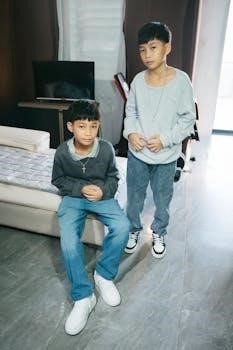master harold and the boys pdf

Athol Fugard’s powerful play, Master Harold…and the Boys, is set in 1950s apartheid South Africa, exploring complex relationships. The play delves into the impact of racism and social injustice through the interactions of three characters. It is autobiographical, and considered one of Fugard’s masterpieces.
Overview of the Play
Master Harold…and the Boys is a poignant one-act drama by Athol Fugard, set in a tea room in Port Elizabeth, South Africa. The play unfolds during a rainy afternoon in 1950, focusing on the evolving dynamics between a white teenager, Hally, and two black employees, Sam and Willie. The narrative examines the insidious effects of apartheid and the complexities of personal relationships against a backdrop of racial inequality. The play’s power lies in its exploration of betrayal, friendship, and the painful realities of a segregated society. It is a coming-of-age story with a cruel twist.
Setting and Time Period
The play is set in Port Elizabeth, South Africa, in 1950. This period is significant as it is during the height of the apartheid era. The setting is the St. George’s Tea Room.
Apartheid South Africa in 1950
The play’s setting in 1950 apartheid South Africa is crucial, as it establishes a society deeply divided by racial segregation. This was a time of institutionalized racism, where white citizens held power, while black individuals faced severe oppression and discrimination. The rigid social hierarchy prevalent at this time is a key element in the play, influencing every interaction and relationship portrayed. The laws and attitudes of this era permeated every aspect of life.

Characters
Master Harold…and the Boys features three pivotal characters⁚ Hally, a white teenager; and Sam and Willie, two black men working for Hally’s family. Their interactions drive the play’s exploration of race and relationships.
Hally (Harold)
Hally, a seventeen-year-old white South African, is at the heart of the play’s conflict. He is caught between the influence of his racist father and the guidance of Sam, his black friend and caregiver. Hally’s internal struggle and his coming-of-age are central themes. He is known as ‘Master Harold,’ a title reflecting the racial hierarchy of apartheid. Hally’s character embodies the internalized racism and societal prejudices prevalent in 1950 South Africa, showing his complex development throughout the play.
Sam
Sam, a middle-aged black man, is a waiter and a significant figure in Hally’s life. He acts as a mentor and friend to Hally, offering guidance and wisdom. Sam is intelligent, dignified, and tries to teach Hally about equality and compassion. Despite the racial hierarchy, Sam maintains a sense of self-respect, which he tries to instill in Hally. His relationship with Hally is complex, and the play’s climax reveals the depth of their connection and the consequences of its violation.
Willie
Willie, also a middle-aged black man, works alongside Sam as a waiter. He is more reserved and less articulate than Sam, but equally affected by the racism of their society. Willie’s primary focus is on ballroom dancing, a form of escape and aspiration. He observes the complex relationship between Sam and Hally, often seeing the injustice of their interactions. Willie’s character provides a contrasting perspective to Sam’s, highlighting the different ways individuals cope with oppression and inequality.
Themes
Master Harold…and the Boys explores themes of racism and apartheid, highlighting their corrosive effects on relationships. It also examines coming-of-age, power dynamics, and the complex nature of friendship amidst injustice. The play deeply delves into these themes.
Racism and Apartheid
The play vividly portrays the pervasive racism of apartheid South Africa, where the white minority held power. The institutionalized bigotry is evident in the characters’ interactions, particularly in Hally’s treatment of Sam and Willie. The play examines how deeply ingrained racial prejudice can be, even affecting relationships of friendship and mentorship. The society’s structure is shown to corrupt even those who have close bonds, highlighting the destructive impact of apartheid on individuals and their connections with each other.
Coming-of-Age
Master Harold…and the Boys is also a coming-of-age drama, charting Hally’s tumultuous journey from adolescence to adulthood. His interactions with Sam and Willie shape his understanding of the world and his place in it. Hally’s struggle to define his own identity against the backdrop of apartheid leads him to make choices that have profound consequences. The play examines the painful process of growing up within a racially divided society. The narrative explores how societal pressures and personal choices can affect a young person’s development.
Power Dynamics and Relationships
The play keenly illustrates the power dynamics inherent in apartheid South Africa. The relationships between Hally, a young white man, and Sam and Willie, two older Black men, are fraught with tension. Hally’s position of privilege allows him to exert control over Sam and Willie. The play reveals how these power imbalances affect the characters’ interactions and create a volatile atmosphere. The seemingly friendly relationships are always shadowed by the racial hierarchy of the time, highlighting the complexity of human connections.

Plot Summary
The plot centers on a rainy afternoon in South Africa, where Hally, Sam, and Willie interact in a tea room. Their relationships shift dramatically, revealing the deep-seated tensions of apartheid society.
Initial Interactions and Relationships
The play opens with Sam and Willie, two Black employees, in a relaxed setting, practicing ballroom dance. Their easy camaraderie is evident as they share moments of laughter and teach each other. Hally, a white teenager, enters, and the dynamic changes. He engages with Sam in intellectual discussions, showcasing a close, almost familial bond. Their interactions highlight the complex relationships that exist beyond the racial boundaries of apartheid. There’s a sense of ease and familiarity, yet the underlying power imbalance is palpable.
The Turning Point and Conflict
The arrival of Hally’s father, a man with racist views, marks a pivotal shift in the play. Hally’s mood darkens as his frustration with his father rises; This leads to him lashing out at Sam, demanding he address him as “Master Harold,” a symbol of the racial hierarchy. Sam’s initial calm response gives way to a profound sense of hurt as Hally continues with racist jokes, revealing the deep-seated prejudices he holds. This moment of conflict shatters the earlier rapport.
Climax and Aftermath
The climax occurs when Hally, consumed by anger and internal conflict, spits in Sam’s face, a deeply humiliating and symbolic act of racial betrayal. This action irrevocably damages their relationship. Sam’s dignity and restraint throughout the play makes Hally’s cruelty even more profound. The aftermath sees Hally grappling with the destruction he has caused, his self-respect diminished. The play ends on a somber note, highlighting the devastating consequences of racism and the loss of innocence.

Critical Reception and Awards
Master Harold…and the Boys garnered significant critical acclaim, winning a Drama Desk Award and London Critics Circle Theatre Award. Zakes Mokae received a Tony Award for his performance as Sam, highlighting the play’s powerful impact.
Initial Impact and Controversy
The debut of Master Harold…and the Boys deeply affected audiences, with many troubled by its stark portrayal of South African society. The play’s unflinching examination of racism and its impact on personal relationships sparked considerable controversy. Some viewers found the depiction of Hally’s behavior towards Sam and Willie disturbing, leading to intense discussions about the play’s themes and message regarding apartheid-era relationships and its impact on audiences.
Recognition and Awards
Master Harold…and the Boys garnered significant recognition, including a Drama Desk Award for Outstanding New Play. It also received the London Critics Circle Theatre Award for Best Play in 1983. Furthermore, Zakes Mokae, who played Sam, won a Tony Award for Featured Actor in a Play, highlighting the powerful performances within the production. These accolades underscore the play’s impact and its place as a pivotal work exploring racial dynamics and the struggle against apartheid.
Historical Context
The play is set in 1950s apartheid South Africa, a time of institutionalized racism and segregation. This period profoundly shaped the characters’ relationships and the conflicts depicted in the play. It reflects the pervasive injustices of the era.
Influence of Apartheid on the Play
Apartheid’s rigid social hierarchy permeates every aspect of the play, dictating the power dynamics between Hally, a white teenager, and Sam and Willie, his Black servants. The system’s inherent racism affects their relationships, creating a complex web of dependence and resentment. The play showcases how apartheid normalizes the concept of racial superiority, influencing even seemingly personal interactions. The title itself, with “Master Harold,” highlights the ingrained power imbalance and the systemic oppression that defines their world, creating a society where dignity is unequally distributed.
Analysis of Key Scenes
The play’s power lies in its intense scenes, revealing the characters’ evolving relationships. These moments highlight the impact of apartheid on their lives, exposing the complexities of race and identity. The drama unfolds through pivotal interactions.
The “Master Harold” Incident
The pivotal “Master Harold” incident showcases Hally’s destructive assertion of his racial superiority. He demands that Sam address him formally, stripping away their friendship. This act embodies the internalized racism of apartheid and the abuse of power. This moment is the climax of the play and reveals Hally’s true nature. Sam’s dignified response to this degradation is an extremely heartbreaking moment, underscoring the pain of oppression and betrayal. The scene dramatically shifts the dynamics between the characters. Hally’s choice has irreparable consequences.

Adaptations
Master Harold..;and the Boys has been adapted into a film, directed by Lonny Price. This adaptation brings the play’s intense themes and relationships to a wider audience. The movie stars Ving Rhames and Freddie Highmore.
Film Adaptations
The most notable adaptation of Master Harold…and the Boys is the 2010 film directed by Lonny Price. This cinematic version stars Ving Rhames as Sam, Freddie Highmore as Hally, and Patrick Mofokeng as Willie. The film aims to capture the play’s raw emotional intensity and the stark reality of apartheid. It provides a visual representation of the tea room setting, enhancing the dramatic impact of the story. The film allows a broader audience to experience the powerful themes of racism and coming-of-age explored in Fugard’s original work.